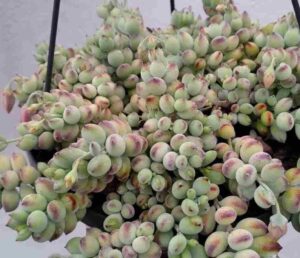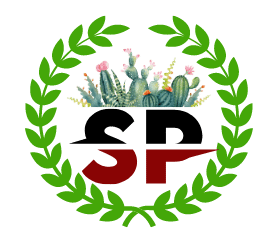Introduction
Cotyledon pendens is a rare trailing succulent plant of the Crassulaceae family. This is a much branched shrublet. It has a hanging stem that measures 60 cm in length. This plant is also known by the name of cliff cotyledon. During summer months this plant grows on rocky outcrops. They become dormant in winter and spend most of the time in cracks and crevices. Having this plant inside your house is really mesmerising.

Plant Characters
The characters of plant are explained below:
Roots
This plant has a fibrous root system. Roots are not succulent.
Stem
This plant is heavily branched and consists of many hanging stems. These hanging stems can reach up to 2 feet in length. It has a fleshy green bulbous stem. Stems are initially soft and flaccid and whitish green in colour.
Leaves
Leaves are thick. Leaves usually appear in opposite pairs and are highly succulent. First leaves i.e. cotyledon leaves are green but later they turn chalky, grey-green and whitish with a reddish margin. Leaves have sparse hairs when young and become hairless with age. Also, the colour of the leaves changes with season, temperature, drought and prevailing light intensity.
Also Read: Triangle Cactus (Acanthocereus tetragonus): Care And Propagation
Flowers
This plant usually flowers during spring and summer. It produces hanging bell-shaped flowers at the end of the branches. Flowers are orange red in colour.
Climate
This plant is native to tropical climates. Being native to tropical climate, it requires a hot summer and cool dry frost free winter. Annual precipitation of 1000 to 1200 mm is sufficient for this plant.
USDA Growing Zone
This plant is best suited for USDA hardiness zones 10a to 11b: from 30 oF to 50 oF.
Origin and Distribution
This species is native to Eastern Cape, South Africa. From South Africa, it has been distributed to various parts of the world. Nowadays, this plant is found in all tropical areas.

Where To Grow This Plant?
Cotyledon pendens are suitable for both indoor and outdoor gardening. However, for outdoor cultivation protection from the frost during the winter month must be ensured. This unique succulent does well in containers while growing indoors and requires a dry frost free place for outdoor cultivation.
Types Of Cotyledon Pendens
Till now following two types of cotyledon pendens are reported:
1. Evergreen cotyledon pendens
Evergreen cotyledon pendens primarily grow in the summer season.
2.Deciduous cotyledon pendens
Deciduous cotyledon pendens grow in winter and shed their leaves in summer. They generally produce large fresh stems.
Special Features
- This plant possesses hanging branches and flowers.
- This plant is best suited for hanging baskets.
- Their succulent leaves possess hairs when they are young and become hairless with age.
Is It Difficult To Care For Cotyledon Pendens?
Unlike other succulent, cotyledon pendens have medium level of difficulty in planting and cultivation. Its care differs slightly from other trailing and spreading succulent.
Botanical Classification
Kingdom: Plantae
Clade: Tracheophytes
Clade: Angiosperms
Clade: Eudicots
Order: Saxifragales
Family: Crassulaceae
Sub-family: Kalanchoideae
Genus: Cotyledon
Species: pendens
Is It Toxic?
This plant is toxic to pet animals like cats and dogs. The toxicity is due to the poisonous sap. This poisonous sap is also toxic to goats and pigs. The severity of toxicity depends upon the dose ingested. Following are the associated symptoms of Cotyledon Pendens toxicity:-
1. Diarrhoea
2. Vomiting
3. Muscle tremors
4. Seizures
Cotyledon Pendens Variegated
Cotyledon pendens variegated with chalky green white leaves with red lined tips is an attractive succulent to grow. The leaves and flowers of these variegated plants are similar to that of non-variegated plants.
Care
While growing this plant, you have to consider the following things.
Light
Cotyledon pendens plant prefers ample sunlight. This plant performs well in sunny situations without direct sunlight. Intense sunlight for longer duration can cause sunburn. Areas receiving bright but filtered sunlight are suitable for growing this plant. At least six hours of sunlight is required for proper growth and development of plants. Under low light conditions, you should have the provision of artificial lighting.
Temperature
Temperature range of 55-90 oF is suitable for this plant. Temperatures below and above this range are detrimental for the growth and development of plants. The colour of leaves and flowers may vary according to the prevailing temperature.
Soil
Like other succulents this plant also prefers well drained soil. It means that this plant does not like to sit in water. Any common succulent soil mix is suitable for this plant. Generally neutral to acidic, sandy-gritty soil is preferred to avoid the root rot.
Water
This plant has thick leaves that stores water and helps them to thrive under water stress conditions. Being a succulent plant this plant also does not require much water. This plant is drought tolerant. The soil should be allowed to dry completely between watering. As this plant requires less water, watering is carried out occasionally. You need not to water during the dormant season.
Humidity
About 40 % of relative humidity is good for this plant. However, this plant can also perform well in high humid areas. Humidifiers should be used in dry areas to ensure the required humidity.
Fertilisers
Fertilising once or twice during the growing season is sufficient for this plant. Plant needs to be fertilised when its growth slows down. Always use poor nitrogen fertiliser for fertilising. So, you need not be worried about the fertiliser.
Potting And Repotting
For potting pots of appropriate size should be selected. Appropriate nutrient media should be used. Cotyledon pendens best grow in the hanging basket. It allows the stem of the plant to grow outward and cascade downwards. Pot bound condition hinders the normal growth and development of plants. Also, after certain times nutrients in growing media gets exhausted. So repotting is essential. For repotting pots of larger dimension is required. Plant should be watered before repotting.

This facilitates pulling out of the plant without much damage. After pulling, the damaged and unnecessary roots need to be removed. Then, the plant is re-planted in the new container with new growing media. Watering should be practised for days after repotting.
Trimming And Pruning
Under optimum growing conditions this plant grows promptly. So. pruning is necessary to maintain the aesthetic beauty of the plant. Pruning helps to limit the plant to the desired space and also prevents it from spreading too much.
Propagation
This plant can be propagated both sexually and asexually. The following are the propagation methods for this plant:
1. Seed
Seeds are sown during the summer.
Sowing depth is 2-3 mm and seeds are sown in close spacing.
Germination occurs in about 3 weeks.
2. Stem cutting
This is an asexual method of propagation. Follow the following steps:
- First select the young, straight vigorously growing healthy branch.
- Cut the stem with a few leaves attached to it.
- Plant them in a pot containing nutrient media.
- After certain days rooting may occur.
3. From Leaves
For leaf propagation the entire leaf is removed and is set in a shady spot. After three weeks, roots will form on the leaf and a new plant will be developed at the base. After rooting, they are transplanted in the pots. During this period indirect light is preferred by this plant. So, maintain indirect light.
4. Offsets Propagation
This plant can be propagated by offsets. Following procedure are followed:
- Remove offset from the root clustered base.
- Remove the old leaves that may retain water.
- Prior to planting, soak it for minutes to enhance seedling emergence.
- Rooted offset are planted 2 inches deep.
- Under extreme drought conditions, water on a weekly basis.
Pests
1. Mealybugs
Mealybugs mainly sucks sap from the leaves of the plant.
They can be best controlled by spraying soap water or neem oil.
2. Scales
3. Sucking bugs
Diseases
1. Cotyledon rot
This problem is due to excess water.
This can be prevented by avoiding the excess moisture.
Price
A well grown healthy Cotyledon pendens may cost up to $4.15. However, prices may vary according to the place and demand.
Pros
- It requires low maintenance.
- This plant has attractive succulent foliage.
- They also have medicinal properties.
Cons
- This plant consists of toxic sap. Sap of this plant is toxic to dogs and pigs.
- This plant is intolerant to cold.
- This plant is susceptible to water logging condition.
Conclusion
Cotyledon pendens is a popular choice for succulent enthusiasts. This is native to South Africa and is a rare trailing succulent of crassulaceae. It is one of the succulents that can be propagated easily. This plant prefers bright but indirect sunlight. A temperature range of 55-90 oF is suitable for cultivation of this plant. Low humidity is preferred by this plant. The unique feature of the plant is that it has got hanging branches and flowers. This plant has toxic sap that is toxic to cats and dogs. So, it is better to avoid these pets from this plant. As this plant requires low maintenance, it is also good for beginners. Being a rare plant, it is hard to find this plant.


